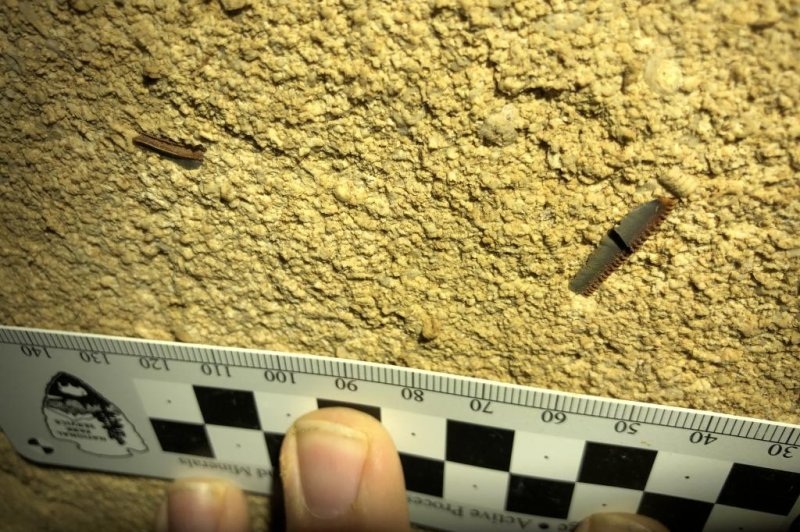Ancient shark found inside Kentucky's Mammoth Cave
By Brooks Hays

Scientists found the fossilized remains of an ancient shark head, including portions of its jaw, cranial cartilage and several teeth, embedded in the wall of a remote chamber of Mammoth Cave in Kentucky. Photo by the National Park Service
Jan. 30 (UPI) -- Scientists have identified the 330-million-year-old remains of an ancient shark inside Kentucky's Mammoth Cave National Park.
While exploring and mapping Mammoth Cave's many remote chambers, expert spelunkers Rick Olson and Rick Toomey happened upon a fossilized jaw and several teeth embedded in a cave wall.
Olson and Toomey took pictures of the fossils and sent them to Vincent Santucci, senior paleontologist with the National Park Service. Santucci reached out to John-Paul Hodnett, a paleontologist and expert in the study of Paleozoic sharks.
Hodnett, program coordinator at the Dinosaur Park in Maryland, came to visit the Mammoth Cave fossil. He was excited by what he found. There was enough fossil evidence to identify the ancient shark species as Saivodus striatus.
"Though fossil shark teeth have been discovered at Mammoth Cave before, they have never been scientifically documented until now," Hodnett told UPI Thursday in an email. "The discovery of fossilized cranial cartilage associated with teeth of the Saivodus striatus, a species of shark previously only known from teeth, just added some important anatomical information that can help us better understand how this ancient shark lived and who it was related to."

Scientists found the fossilized remains of an ancient shark head, including portions of its jaw, cranial cartilage and several teeth, embedded in the wall of a remote chamber of Mammoth Cave in Kentucky. Photo by the National Park Service
Scientists aren't sure if the remains are part of a full skeleton. So far, researchers have only identified and documented parts of the jaw and cranium, along with several teeth. But the size of the ancient shark head suggests the specimen was similar in size to a great white shark, measuring somewhere between 11 and 21 feet.
It's possible more fossils are hidden in the walls of the cave.
Saivodus striatus remains have been previously identified at a number of Late Mississippian dig sites in the United States and Europe. During the Late Mississippian, some 330 million years ago, Kentucky was covered by a large shallow sea of warm water.
"Forests of sea lilies, a relative to starfish, dominated the sea floor, along with early solitary corals and bivalved animals called brachipods," Hodnett said. "The most common fish at this time were sharks and their kin."
Though scientists were thrilled to find the ancient shark head, Mammoth Cave National Park boasts a rich fossil heritage. Scientists with the National Park Service have recently begun a paleontological resource inventory at the park.

Scientists found the fossilized remains of an ancient shark head, including portions of its jaw, cranial cartilage and several teeth, embedded in the wall of a remote chamber of Mammoth Cave in Kentucky. Photo by the National Park Service
"We are just beginning this effort and already had some exciting discoveries," Santucci told UPI. "We have two categories of fossils that we are focusing on at Mammoth Cave National Park, including: one, fossils which are preserved in the Paleozoic marine limestones in which the caves actually developed. These are largely marine invertebrates and some rare fossil vertebrates such as the sharks."
"Two: there are also ice age fossils from Mammoth Cave National Park," Santucci said. "These are largely Pleistocene mammals who either inhabited the caves periodically or the remains of organisms that were dragged in by predators or somehow transported into the caves."
As Santucci and his colleagues continue to investigate the national park's paleontological treasures, they plan to publish and present a scientific paper detailing the discovery and identification of Saivodus striatus.
The team of scientists also hope to find a way to share information about the new shark discovery through both a website and potentially a public display at the park itself.
upi.com/6980494
No comments:
Post a Comment